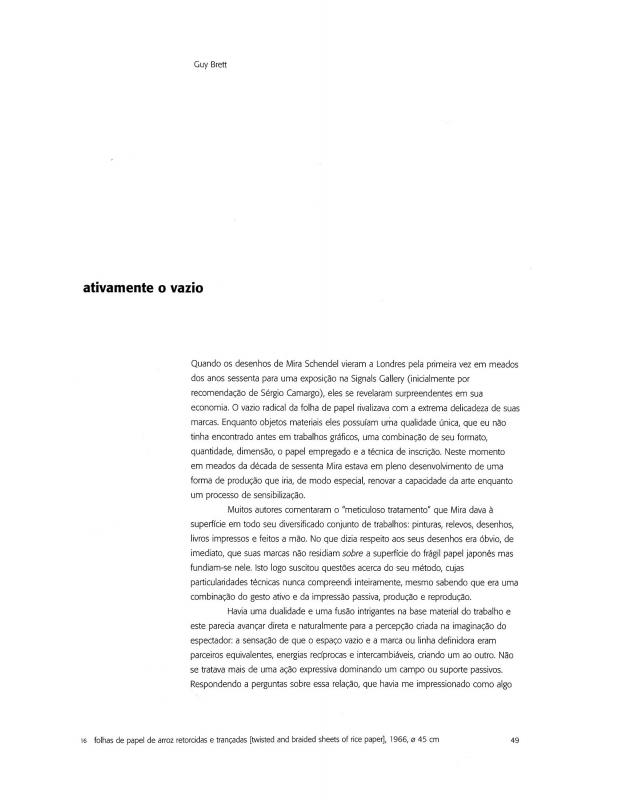First published in Guy Brett’s book Kinetic Art, this essay attests to the intellectual intensity of the relationship between its author and Brazilian art—with which Brett first came into contact in Paris through Sergio Camargo in 1964. The next year, Brett began corresponding with Mira Schendel, who would exhibit in London in 1966. Brett would write on Schendel’s radical work again three decades later, in 1996, when he further developed the arguments laid out in this brief essay. That later text was published under the title “Ativamente o vazio” [see doc. no. 1111214] in a book edited by Sônia Salzstein.
Born in Switzerland, artist Mira Schendel (1919–88) settled in Brazil in 1952. She became widely known for drawings on rice paper as well as pictorial and three-dimensional work that addressed philosophy, in particular anthroposophy, from early on. She made her first monotypes on rice paper in 1964, and she produced some two hundred drawings that year, each one with phrases or words in Italian, German, and/or Portuguese, the languages that due to the artist’s background, were most familiar to her. With these works, she participated in the VIII São Paulo Biennial in 1965. For the Droguinhas series discussed here, which was produced in 1966, the artist twisted and knotted the rice paper support.
London-based art critic, curator, and international lecturer Guy Brett (b. 1942) was the cofounder, with Paul Keeler, of the gallery Signals and of the publication Newsbulletin of Signals. He worked closely with Mira Schendel, holding a solo show of her work at Signals in 1966. Brett’s essays, which almost always have a radical or experimental bent, are published regularly in international art magazines; he has also written monographic essays. He did significant work on Kinetic art from the time of the emergence of that movement in Europe and Venezuela. His widely known books include Kinetic Art: The Language of Movement (London: Studio Vista, 1968); Force Fields: Phases of the Kinetic (London: Hayward Gallery, 2000); Carnival of Perception: Selected Writings on Art (London: Institute of International Visual Arts, 2004); and this text, Brasil experimental - arte/vida: proposições e paradoxos (org. Kátia Maciel) (Rio de Janeiro: Contra Capa Livraria, 2005).
For more information on Brett’s work on Brazilian art, see “Uma cronologia de encontros, 1964-2005” [doc. no. 1111303].


